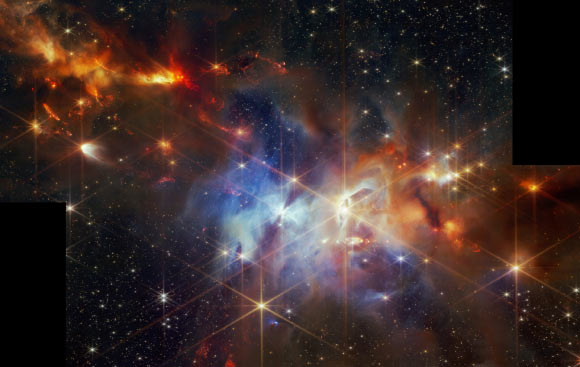These protostellar outflows are formed when jets of gas spewing from newborn stars collide with nearby gas and dust at high speeds. Typically these objects have a variety of orientations within one region. Within the Serpens Nebula, however, they are all slanted in the same direction, to the same degree, like sleet pouring down during a storm.

This Webb image shows a grouping of aligned protostellar outflows within one small region (the top left corner) of the Serpens Nebula. Image credit: NASA / ESA / CSA / STScI / K. Pontoppidan, NASA’s Jet Propulsion Laboratory / J. Green, Space Telescope Science Institute.
“So just how does the alignment of the stellar jets relate to the rotation of the star?” the Webb astronomers said.
“As an interstellar gas cloud collapses in on itself to form a star, it spins more rapidly.”
“The only way for the gas to continue moving inward is for some of the spin (known as angular momentum) to be removed.”
“A disk of material forms around the young star to transport material down, like a whirlpool around a drain.”
“The swirling magnetic fields in the inner disk launch some of the material into twin jets that shoot outward in opposite directions, perpendicular to the disk of material.”
“In the Webb image, these jets are identified by bright red clumpy streaks, which are shockwaves caused when the jet hits the surrounding gas and dust.”
“Here, the red color indicates the presence of molecular hydrogen and carbon monoxide.”
“Webb can image these extremely young stars and their outflows, which were previously obstructed at optical wavelengths.”
“There are a few forces that potentially can shift the direction of the outflows during this period of a young star’s life.”
“One way is when binary stars spin around each other and wobble in orientation, twisting the direction of the outflows over time.”
The Serpens Nebula is a so-called reflection nebula located approximately 1,300 light-years away in the constellation of Serpens.
The object is between 1 and 2 million years old, which is very young in cosmic terms.
“The Serpens Nebula is also home to a particularly dense cluster of protostars (around 100,000 years old) at the center of this image, some of which will eventually grow to the mass of our Sun,” the astronomers said.
“It is a reflection nebula, which means it’s a cloud of gas and dust that does not create its own light but instead shines by reflecting the light from stars close to or within the nebula.”
“So, throughout the region in this image, filaments and wisps of different hues represent reflected starlight from still-forming protostars within the cloud.”
“In some areas there is dust in front of that reflection, which appears here in an orange, diffuse shade.”
“This region has been home to other coincidental discoveries, including the flapping Bat Shadow, which earned its name when 2020 data from the NASA/ESA Hubble Space Telescope revealed it to flap, or shift. This feature is visible at the centre of the Webb image.”
The findings were published in the Astrophysical Journal.
_____
Joel D. Green et al. 2024. Why are (almost) all the protostellar outflows aligned in Serpens Main? ApJ, in press;
>>> Read full article>>>
Copyright for syndicated content belongs to the linked Source : Breaking Science News – https://www.sci.news/astronomy/webb-protostellar-outflows-serpens-nebula-13037.html






























